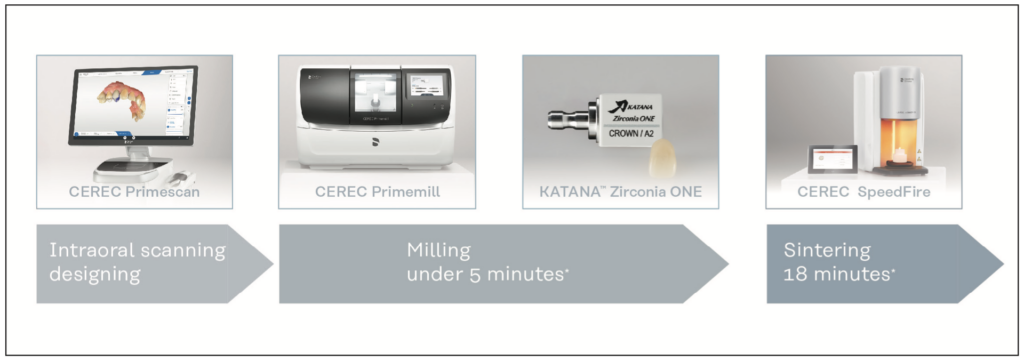In the last decade, dentistry has witnessed a remarkable evolution with the introduction of innovative materials and technologies. Among these advancements, the speed of sintering zirconia has emerged as a game-changer, revolutionizing the fabrication of zirconia restorations. Zirconia, a robust ceramic material known for its strength, has gained aesthetic appeal and is fast becoming the preferred choice in dentistry. However, the traditional sintering process was time-consuming, and most zirconia restorations were fabricated by dental technicians at their dental labs. The advent of speed sintering has addressed this challenge, bringing efficiency and speed to the forefront of dental prosthetics. This advancement makes it possible for dentists to deliver zirconia in one-day dental treatments. The new technology makes it possible to fabricate a full zirconia KATANA Zirconia ONE (Kuraray Noritake) single-unit restoration in approximately 35 minutes (Figure 1).

ZIRCONIA TYPES
Zirconia, a crystalline oxide of zirconium, possesses exceptional mechanical properties, making it an ideal material for dental applications. Yttria-stabilized zirconia is one of the most common types of zirconia, as yttria is used as the stabilizing oxide. Many researchers describe properties of zirconia by its yittria concentration, such as 3Y, 4Y, and 5Y. However, such classifications may need a revision since most powders are sourced and blended with different properties, which can affect sintering time. Kuraray Noritake uses its own zirconia powder with claims of speed sintering in 18 minutes for single crowns (Figure 2).

THE SPEED SINTERING PROCESS
Speed sintering involves subjecting zirconia restorations to elevated temperatures for shorter durations, significantly reducing the overall processing time. Traditional sintering methods often take several hours, whereas speed sintering can be accomplished with the same results in a matter of minutes. This acceleration is achieved through precise control of temperature and heating rates, ensuring the restoration’s structural integrity while expediting the production timeline.
ADVANTAGES OF SPEED SINTERING
Time Efficiency: The primary advantage of speed sintering is its unparalleled time efficiency. The process efficiency opens new possibilities for dental practitioners by offering greater flexibility in managing production schedules. The reduced processing time enables clinicians to accommodate urgent cases and respond promptly to patient needs.
Cost-Effective: The efficiency gained through speed sintering translates into cost savings for both dental laboratories and patients. The reduced production time decreases labor costs and allows for more competitive pricing for zirconia restorations.
Precision and Quality: Despite the accelerated process, speed sintering maintains the high precision and quality associated with zirconia restorations. The controlled heating parameters ensure that the final product meets the stringent standards of durability and aesthetics.
There is independent research that shows that speed sintering can produce equal or better strength of zirconia (Liu H, et al. Dent Mater. 2022;38[2]:451-68).
CONCLUSION
The advances of speed sintering in zirconia restorations have ushered in a new era of efficiency and convenience in dentistry. As technology continues to advance, the integration of such innovations not only improves the workflow for dental professionals but also enhances the overall patient experience.
For more information, call Kuraray America at (800) 879-1676 or visit kuraraydental.com.


